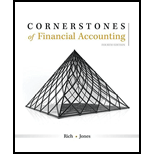
Cornerstones of Financial Accounting
4th Edition
ISBN: 9781337690881
Author: Jay Rich, Jeff Jones
Publisher: Cengage Learning
expand_more
expand_more
format_list_bulleted
Concept explainers
Question
Chapter A1, Problem 10MCQ
To determine
Concept introduction:
International financial reporting framework (IFRS):
International
To choose:
The true statement about the
Expert Solution & Answer
Want to see the full answer?
Check out a sample textbook solution
Students have asked these similar questions
Overhead rate per direct labour hour
Calculate Miller's activity rate
Using the information below, calculate the net income for the period:
Account
Amount
Beginning Raw Materials Inventory $18,500
Ending Raw Materials Inventory $22,750
Beginning Work in Process Inventory $42,300
Ending Work in Process Inventory ||$39,800
Beginning Finished Goods Inventory $63,400
Ending Finished Goods Inventory
Cost of Goods Sold for the period
Sales revenues for the period
Operating expenses for the period
$71,250
$465,000
$895,000
$176,000
a. $430,000
b. $254,000
c. $627,850
d. $312,500
e. $210,750
Chapter A1 Solutions
Cornerstones of Financial Accounting
Knowledge Booster
Learn more about
Need a deep-dive on the concept behind this application? Look no further. Learn more about this topic, accounting and related others by exploring similar questions and additional content below.Similar questions
- Provide answerarrow_forwardA firm sells 3,800 units of an item each year. The carrying cost per unit is $3.56 and the fixed costs per order are $84. What is the economic order quantity? (Please round units to the nearest whole number)arrow_forwardColson Manufacturing uses a job order costing system.During one month, Colson purchased $178,000 of raw materials on credit; issued materials to the production of $267,000 ofwhich $16,000 were indirect. Colson incurred a factory payroll of $192,000, of which $35,000 was indirect labor. Colson uses apredetermined overhead rate of 150% of direct labor cost. The total manufacturing costs added during the period are_.arrow_forward
arrow_back_ios
SEE MORE QUESTIONS
arrow_forward_ios
Recommended textbooks for you
 Auditing: A Risk Based-Approach (MindTap Course L...AccountingISBN:9781337619455Author:Karla M Johnstone, Audrey A. Gramling, Larry E. RittenbergPublisher:Cengage Learning
Auditing: A Risk Based-Approach (MindTap Course L...AccountingISBN:9781337619455Author:Karla M Johnstone, Audrey A. Gramling, Larry E. RittenbergPublisher:Cengage Learning

Auditing: A Risk Based-Approach (MindTap Course L...
Accounting
ISBN:9781337619455
Author:Karla M Johnstone, Audrey A. Gramling, Larry E. Rittenberg
Publisher:Cengage Learning
